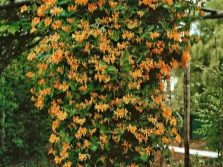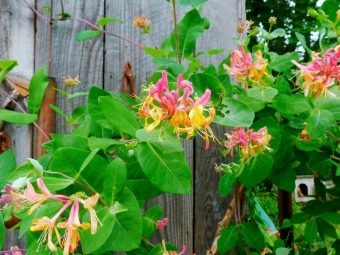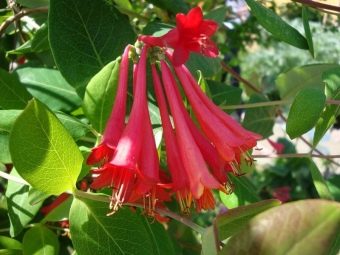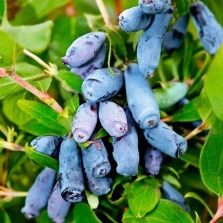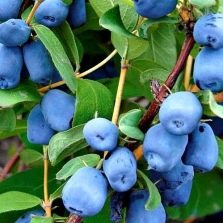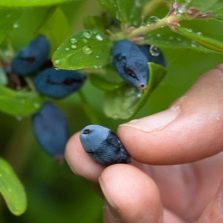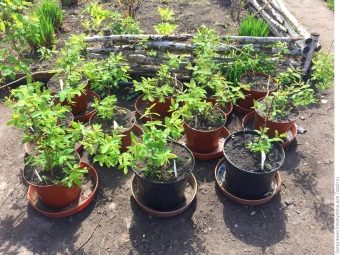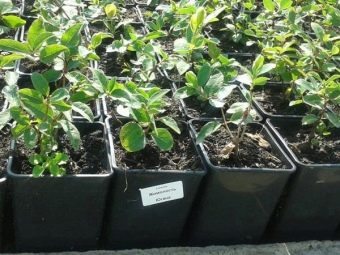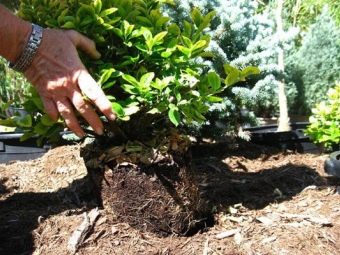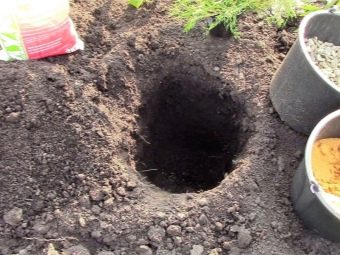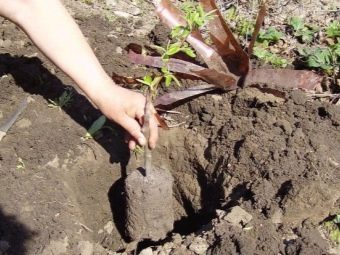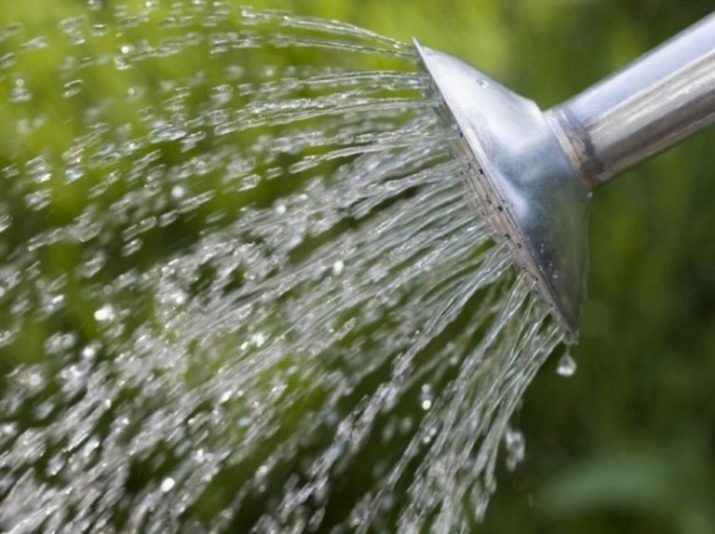Decorative curly honeysuckle: types, description and care
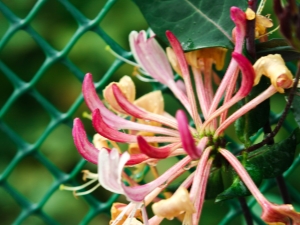
Every gardener wants to see his plot beautiful, so many plant curling honeysuckle, which gives the garden real beauty and unique charm.It grows quite quickly and adorns the wall, fence or arch. The plant creates a cosiness, fills a site with paints and magic aroma.
general description
Honeysuckle belongs to the ornamental shrubs of the family Honeysuckle. Culture owes its name to the world-famous botanist Carl Linnaeus, and the first most complete description of the plant appeared in the works of the 18th century Russian researcher Stepan Krasheninnikov.
In the natural environment of the central zone of Russia, wild culture is ubiquitous in groves and forest edges. These plants are well known as a wolfberry, it has yellowish inflorescences and bright red berries, and the leaves are pubescent from below. In the southern territories, it is exclusively a garden culture and does not grow wild.
The garden culture most familiar to us is erect, as well as climbing or creeping bushes that look great in groups of plantings, alleys and gazebos.
Flowers of honeysuckle of all varieties are large, but their colors can be varied - pink, red, yellow, orange or white. From the cup goes a tubular corolla divided into 5 equal parts. The pistil is quite long, with several stamens in each flower. Fruits can be yellow, blue, black or red, arranged on a branch in pairs.
Honeysuckle is cultivated in almost all countries of the northern hemisphere, and there are about 200 plant species. Only in the territory of our country you can find at least 50 varieties, and only 10-15 of them are edible.
All types and varieties can be divided into three categories depending on their appearance:
- varieties that resemble small trees;
- bush honeysuckle;
- climbing vines (they are also called climbing or spinning).
It is the latter category that is most often found in gardens and household plots - it attracts attention with its luxurious buds of all colors of the rainbow. Even the most inconspicuous plot is transformed before our eyes and acquires a special romance and piquancy, if you decorate it with honeysuckle plantings.
Gardeners often combine several varieties of this plant, so that at the time of flowering the area is filled with the brightest colors - from light pink to rich purple. No less exotic are the ripened fruits of honeysuckle, which, depending on the variety, can appear both in summer and in the first weeks of autumn.
Honeysuckle exudes a rich aroma, so it is used to decorate family recreation areas. The plant is often used by landscape designers - from it form elegant pergolas, arbors and stylish slopes.
Varietal variety allows you to use the plant for decoration of interesting compositions and even alpine slides.
Types and varieties
In nature, there are about 200 species of honeysuckle. Consumers around the world cultivate Himalayan, Primorskaya and other varieties.
"Kaprifol" - This is the most common variety of honeysuckle in our country, it is a perennial deciduous vine, which, with proper care, often grows up to 6 m in length. Since mid-May, the plant is literally covered with flowers. Flowering lasts 16-20 days. However, even after its completion, the plant does not lose its exoticism, because green berries appear on it, which gradually redden as they mature and by the end of summer they are replaced by bright beads.
Climbing vine grows quite quickly - in one season it can give a gain of a couple of meters and twist the pergola or climb the wall of the summer house.
"Kaprifol" - quite cold-resistant plant. With strong and prolonged cold, only young shoots tips are exposed to freezing.
It may seem strange, but a warm prolonged winter does much more harm to this variety than cold, since regular thaws lead to swelling of the buds, which die when frost returns. However, even in these unfavorable conditions, “Kaprifol” is reborn from root buds, which, with the onset of spring, produce new shoots.
A very interesting kind of “Caprifoli” is considered to be “Caprifolle German” - it is similar to the main plant, but it is characterized by a longer flowering period, which sometimes lasts until autumn.
Honeysuckle "Kaprifol" does not leave anyone indifferent - it is no coincidence that the passion for this plant began among owners of their own sites in Russia and Europe.
Honeysuckle "Brown" - Another interesting variety that blooms twice per season: the first time - at the end of June - early July, and the second time - in August. Buds have a characteristic carrot color.
Honeysuckle "Brown" prefers open lighted areas, reacts negatively to drafts. Culture does not tolerate harsh long winters, and therefore it should be planted in the southern and central territories of Russia.
Honeysuckle "Henry" - This is a semi-evergreen variety that does not completely shed its leaves for the winter and they remain partially on the shrub. In height, this plant is significantly inferior to its "brothers" - its length does not exceed 2.5 meters. Flowering usually begins in mid-July, the flowers of its scarlet color with an amazing rich aroma. Fruiting begins in September. Frosted black berries have a very interesting shade.
In addition, the following varieties are distributed in our country:
- "Tatarskaya" - one of the hardiest varieties of honeysuckle with pink and white inflorescences;
- Korolkov's honeysuckle has a rich flowering, inflorescences are lilac or pale pink;
- "Gerald" - a plant with large yellow flowers, does not throw off leaves for winter, while tolerating frosts well;
- "Gokrota" differs in flowers of a pinkish-yellow shade, blooms continuously, grows in length by 4-5 meters;
- "Maak" - Liana with large white inflorescences that exude a spicy scent reaches 3-3.5 meters, it is quite resistant to frost;
- honeysuckle "Serotina" - one of the most attractive, which pleases with flowering throughout the summer with small flowers of burgundy-brown hue, their scent is similar to the smell of linden flowers;
- "Japanese" differs in decorative color of leaf plates - they are distinguished by a light green tint with pronounced yellow veins, but this plant does not tolerate frosts, therefore it can be grown only in southern regions.
- "Georgian" honeysuckle is common in the Caucasus, has large purple flowers, which by the end of summer are replaced by red and black fruits;
- "Evergreen" - This is the most resistant to cold winters variety, its vines bloom in late May with unusual flowers: crimson on the outside and bright yellow on the inside.
We should also dwell on edible types of honeysuckle.
“Bakchar giant” - vigorous plant up to 2 m, crown sprawling, and the leaves are dark and very beautiful. The berries are very large - 4-5 cm, the mass of each reaches 2.5 grams. With one bush with good care you can remove up to 4.5 kg of the crop.
Also good taste of fruits differ varieties "Cinderella", "Blue Bird", "Morena", "Amphora" and "Long-fruited". These berries have exceptional taste properties and can be used for eating raw, and for preservation for the winter.
Landing
Honeysuckle seed can be planted, but this process is very complex and time consuming, so not every gardener decides to cultivate a culture with this method.Most often the plant is planted with seedlings, but it is important to choose the planting material.
The sapling should be purchased strictly in specialized plant nurseries or from trusted private owners who plant the necessary plant in their plot, otherwise you are at great risk to get not the sort that you expect, since even the most experienced gardeners are sometimes confused in all varietal characteristics and characteristics.
Choosing a bush, it is advisable to give preference to saplings at the age of 2-3 years, since in this case it is necessary to wait for a very long time for flowering.
Carefully inspect the roots and shoots - they should not be seen any damage, they must be plastic, bend well, do not have dry parts. However, peeling of the bark is allowed - this is the standard state for all varieties of honeysuckle.
The root system of a healthy plant must be strong and powerful; there must be buds on the shoots. Do not buy a bush, if it seemed stunted to you. Even if the seller assures that he will perk up after replanting and watering, it is better to purchase another plant.
For simultaneous cultivation, it is recommended to take at least three varieties so that later there was an opportunity to independently propagate them. Keep in mind that honeysuckle refers to cross-pollinated crops and not all varieties pollinate each other well, so when buying should prefer pair varieties.
It is very important to choose the right place for planting honeysuckle.
Probably, there is not a single garden plant that has the same impressive and rich odor as honeysuckle. It is he who is considered the main factor that influences the choice of a place to grow. Most often, the plant is planted in the place where the household spend the most time and gather with friends and relatives. For abundant flowering, the plant is best placed in a sunny place, although shady areas are more suitable for forest varieties - they will best grow under the crown of spreading trees.
If you prefer climbing species, then you should first take care of the construction of the arch or a special support.
It is desirable that the acid-base reaction was in the range of 5.5 to 6.5. If the earth is acidified, you should add a little lime and dig it. Then the land should be completely free from weeds and make organic and mineral fertilizers.
Purchase a sapling in plastic containers with fertilized earthen clod - in this case, when transplanting, the risk of damage to the root system will be minimized. However, if you plant honeysuckle in early spring after the snow melts or in autumn, then it is optimal that the root is bare.
Time suitable for planting honeysuckle is the end of April - the first decade of May. It is at these times that nature awakens and the plant has good chances to settle in a new place. However, the bushes can be planted even before winter - in this case, the landing work should be carried out in the second half of September.
In order to increase the survival rate of seedlings, one should observe the distance between the bushes: for tall varieties, it should be 2.5 meters, and for undersized - 1 m.
The sequence of actions when landing is standard:
- 3-4 days before planting, prepare the wells and lay them out with rubble, expanded clay or any other drainage.
- On top of it lay out the fertile land. You can make the mixture yourself; for this, two compost buckets are mixed with 1 kg of wood ash and 50 g of superphosphate is added there. If the area is sandy, then it makes sense to add some clay to the prepared substrate.
- A few hours before planting the well watered plentifully.
- Planting material is placed in the center of the hole and covered with prepared soil so as not to deepen the root neck.The earth is watered several times, and then, as it shrinks, a new one is filled and watered again.
- It is advisable to fill the site near the young bush mulch. A good result shows needles, sawdust or peat. This will maintain the required level of humidity and protect the plant from frost if it is planted before winter.
If necessary, all types of honeysuckle can be transplanted to a new place, but this can only be done during the period when the plant does not bloom - optimally in late autumn or immediately after the snow melts. Transplant should be carried out together with the earthy clod.
How to care?
The decorative garden honeysuckle at all stages of its growth and development allows a lot of shoots, while some of them begin to climb and, accordingly, take root. In this regard, you should constantly monitor the growth of seedlings and in a timely manner get rid of extra shoots.
Some varieties, for example, "Kaprifol", endure the winter cold rather tenaciously. However, most of the other varieties retain their viability during the cold season and even if some parts of the plant die, they recover quickly with the onset of heat.
It is very important to maintain a competent regime of moisture. Usually the plant is watered twice a week in hot weather, and if the heat has not yet come, then one irrigation per 7 days will be quite enough. Do not allow the land to dry out - in this case, the fruits will be small, dried, and besides, bitter in taste. At the same time, an overabundance of moisture should not be allowed - the stagnation of water causes the development of varietal diseases and also leads to rotting of the roots, therefore it is desirable to equip an effective drainage.
Like any other horticultural crop, honeysuckle requires fertilization. The plant has a need for minerals. Especially a large number of feedings they need shortly before flowering, because a large number of large inflorescences require a lot of power from the plant in order to please the owners of the site as long as possible.
Plants respond well to ready-made complex preparations that are sold in any store for summer residents, in addition, before winter, you can pour chopped wood ash under each bush. Adult plants like humus, and in summer, experienced gardeners make a mullein infusion or mineral supplements. Optimally to do this until mid-July.
Honeysuckle of all kinds is often subjected to attacks of insect pests. The most unpleasant of them are the leafworm, the smoky moth, and the parasite, the honeysuckle mite. In addition, the plant is susceptible to viral and fungal diseases, and also often encounters powdery mildew.
You can fight pests with the use of insecticides, but with fungal and viral diseases, as a rule, treatment is not possible - the plant dies, so it should be dug out and burned.
As a preventive measure, in order to prevent the emergence of larvae and adult aphids, it is recommended to sprinkle granulated superphosphate or lime around the stem, and it is advised to treat the branches with a 5% urea solution for the winter. In addition, you can carry out spraying drugs "Lepotsid" or "Bitoksibatsillin."
Since honeysuckle refers to ornamental plants, it should be regularly cut to give the bush an aesthetic shape. Usually for this simply cut off the top. This stimulates the growth of young branches on the sides, which increase the bushiness of the vines as a whole. By the way, “Kaprifoli” has one characteristic feature - it is tightly fastened to the support and literally braids it counterclockwise, so carrying out pruning allows not only to give shape, but also significantly rejuvenate the bush. However, if you grow edible types of honeysuckle, then molding can significantly slow down the time of ripening berries.
Honeysuckle refers to covering crops, so it should be tied with agrofiber for the winter.
Breeding
Most often, honeysuckle multiply in one of two ways: layering or grafting.
If you chose the first method, that is, the propagation of culture by layering, you should select a strong branch right after spring thawing and warming up of the soil and bend it to the ground. Layers pinned with a special bracket or you can press it with a simple stone. During the spring and summer period, the branch in the places of contact with the ground will give roots, after which the resulting seedling can be separated and transplanted to a permanent place. As a rule, this is done in the fall or spring of the following year.
Propagation by cuttings carried out in July. In this case, cuttings with a pair of good internodes are cut off from the main plant so that a pair of leaves remain on top. After that, cooked Chubukov placed in a greenhouse or a regular cutting. It can be made by hand from improvised means. To do this, take the usual plastic bottle, cut off the bottom of it and cover this structure with a young stalk. At the same time, the cover should be kept open so that air can enter.
About the variety of decorative honeysuckle "Kaprifol", see the video below.






